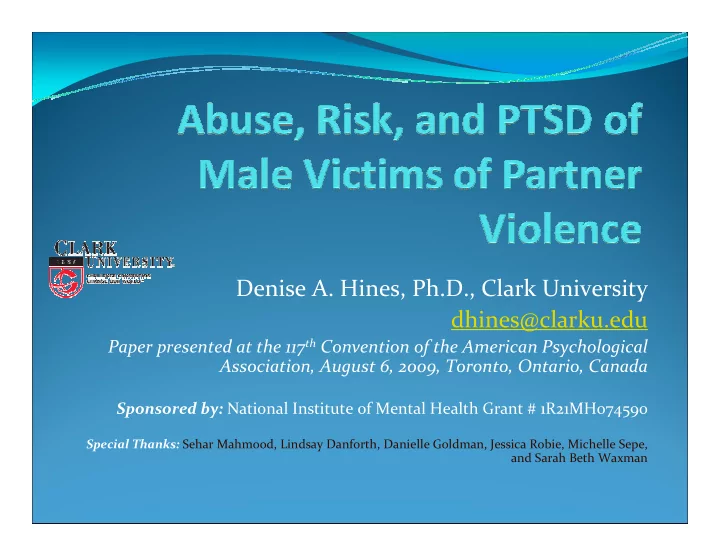

Denise A. Hines, Ph.D., Clark University dhines@clarku.edu Paper presented at the 117 th Convention of the American Psychological Association, August 6, 2009, Toronto, Ontario, Canada Sponsored by: National Institute of Mental Health Grant # 1R21MH074590 Special Thanks: Sehar Mahmood, Lindsay Danforth, Danielle Goldman, Jessica Robie, Michelle Sepe, and Sarah Beth Waxman
Background: Male Victims of Partner Background: Male Victims of Partner Violence Violence � Best population-based studies show that 25%- 50% of all PV victims in a given year are men. � Existence of male victims has been source of much controversy.
Purpose of Today’s Presentation: � Provide empirical descriptive data on: The aggressive behaviors that occur in the men’s 1. relationships and how frequently. Childhood experiences that may put them at risk for 2. sustaining IPV and poor mental health. The possible mental health consequences of 3. sustaining IPV for men.
Methods: Helpseeking Sample • Criteria: – Heterosexual men – Ages 18-59 – In a relationship lasting at least one month in the previous year – Physically assaulted by female partner within previous year – Sought outside assistance/support – Lived in U.S. • N = 302
Methods: Community Sample • Criteria: – Heterosexual men – Ages 18-59 – In a relationship lasting at least one month in the previous year – Lived in U.S. • N = 520
Methods: Survey � Data collected through Internet and phone survey � Demographics � Conflict Tactics Scales � Violence Socialization Scale of the Personal and Relationships Profile � PTSD Checklist
Demographics Helpseekers Community (n = 302) (n = 520) M (SD) M (SD) Male Participants’ Age 40.49 yrs (8.97) 43.68 yrs (10.88)* Female Partners’ Age 37.91 yrs (8.61) 41.73 yrs (11.37)* Male Participants’ $50.4K (25.7K) $49.0K (26.1K) Approximate Income Female Partners’ $30.1K (24.3K) $31.4 (23.7K) Approximate Income ������������������������������������������������������� � �������
Demographics Race/Ethnicity Helpseeking Community (n = 302) (n = 520) Male Female Male Female Participant Partner Participant Partner 74.2% a 83.3% a White 86.8% 84.8% African American 6.0% 7.3% 8.3% 6.0% Hispanic 5.0% 7.6% 5.0% 6.5% Asian American 4.3% 9.3% b 3.1% 4.6% b Native American 2.0% 2.6% 1.0% 2.1% ���� �������������������������������������������������������������������������������� � ������
Relationship Characteristics Helpseeking Community ( n = 302) ( n = 520) M (SD) or % M (SD) or % 8.16 yrs (6.84) a 13.74 yrs (10.92) a Relationship Length 56.3% b 95.8% b % Currently in a Relationship Time Since Relationship 6.10 mths (7.69) 3.26 mths (2.16) Ended ( n = 112) ( n = 22) 73.2% c 45.3% c % of relationships with minor children ������� �������������������������������������������������������������������������������� � �� �����
Q1: Types & Frequency of Aggressive Behaviors Sustained % Who Sustained Psychological & Physical Aggression Helpseeking Community Sample Sample (n = 302) (n = 520) 96.0% a 13.7% a Severe Psychological Aggression 93.4% b 20.0% b Controlling Behaviors 98.7% c 15.4% c Minor Physical Aggression Severe Physical Aggression 90.4% d 5.8% d Any Physical Aggression 100.0% 16.3% �������� �������������������������������������������������������������������������������������� ���������������������������������������� � �������
Q1: Types & Frequency of Aggressive Behaviors Psychological & Physical Aggression Sustained Helpseeking Sample: Community Sample: Mean Mean # of Acts Sustained # of Acts Sustained in in Previous Year Previous Year M (n) SD M (n) SD 9.13 (71) a 28.90 (290) a Severe 26.20 13.26 Psychological 11.36 (104) b Controlling 42.62 (282) b 36.25 16.31 Behaviors 8.66 (80) c 32.01 (298) c Minor Physical 34.33 19.18 11.54 (30) d 16.74 (273) d Severe Physical 22.06 24.08 12.22 (85) e 46.72 (302) e Any Physical 53.48 33.29 ������� ������������������������������������������������������������������������������������������������ ������������������������ � �������
Q1: Types and Frequencies of Aggressive Behaviors % Who Sustained Physical Injuries Helpseeking Community Sample Sample (n = 520) (n = 302) 77.5 a 3.5 a Minor 35.1 b 1.5 b Severe 78.5 c 4.0 c Any ������� �������������������������������������������������������������������������������������� ���������������������������������������� � �������
Q1: Types and Frequencies of Aggressive Behaviors: Intimate Terrorism versus Common Couple Violence � Intimate Terrorism -- violence is one tactic in a general pattern of control of one member of the couple over the other; IPV is frequent, the controlling and violence is not mutual = helpseeking sample. • Common Couple Violence -- low-level, low-frequency violence in a couple where both members are about equally violent; this IPV is not part of an overall pattern of control of one partner over the other = community sample.
Q2: Possible Childhood Risk Factors for Sustaining IPV and Poor Mental Health: Childhood Abuse
Q3: Possible Consequences of Sustaining IPV: Mean Scores on PTSD Checklist
Q3: Possible Consequences of Sustaining IPV: % Scoring Above Clinical Cut-off on PTSD Checklist
Q3: Possible Consequences of Sustaining IPV: Correlations between Frequency of Sustained Aggression and PCL Scores Total Avoidance/ Re-Experi- Hyper- Numbness encing arousal Severe Psychological .21*** .12* .21*** .23*** Controlling .29*** .25*** .24*** .27*** Behaviors Minor Physical .25*** .20*** .23*** .21*** Severe Physical .22*** .18** .21*** .18** Total Physical .25*** .20*** .24*** .21*** ������ ���������������������
#����������� $�������� !������� �&�'� �������"����� �������� ���������%�!
#����������� �(� $�������� !������� �() �&�'� �������"����� �������� �*� ��) ���������%�!
Conclusions � Male helpseekers sustained substantial levels of physical and psychological PV from female partners. � Helpseekers had a stronger history of childhood aggression than men who experienced no violence. � The main concern for helpseekers was PTSD. � Cumulative impact of violent socialization as children and sustaining controlling behaviors and physical IPV as adults.
Recommend
More recommend